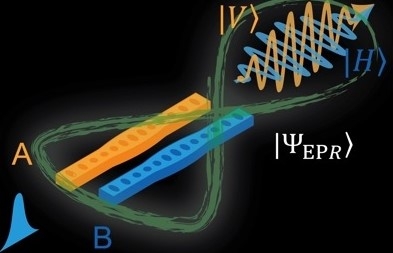

The experiment, performed by Dutch and Brazilian researchers, is an important step toward the construction of a quantum internet (schematic representation of the key steps in the teleportation protocol and its verification; credit: Bas Hensen & Niccolo Fiaschi/TU-Delft)
The experiment, performed by Dutch and Brazilian researchers, is an important step toward the construction of a quantum internet.
The experiment, performed by Dutch and Brazilian researchers, is an important step toward the construction of a quantum internet.

The experiment, performed by Dutch and Brazilian researchers, is an important step toward the construction of a quantum internet (schematic representation of the key steps in the teleportation protocol and its verification; credit: Bas Hensen & Niccolo Fiaschi/TU-Delft)
By José Tadeu Arantes | Agência FAPESP – Researchers at the Delft University of Technology (TU Delft) in the Netherlands and the University of Campinas (UNICAMP) in Brazil have shown that information encoded in a quantum bit (qubit) consisting of a single photon can be teleported to the mechanical motion of an optomechanical device comprising billions of atoms. The achievement offers extraordinary prospects of technological applications, such as the creation of signal repeaters in a future quantum internet. An article reporting the study is published in Nature Photonics.
“As occurs in the classical internet, a quantum internet will require a network of signal repeaters to distribute information to any part of the world. In our study, we obtained the faithful transfer of an unknown quantum state to a remote quantum system. This result enables us to visualize a long-distance quantum communication scenario, necessary for the construction of a future quantum internet,” Thiago Alegre told Agência FAPESP.
Alegre is a professor at the University of Campinas’s Gleb Wataghin Institute of Physics (IFGW-UNICAMP). He is the penultimate author of the article. The last author (and principal investigator for the study) is Simon Gröblacher, a professor at TU Delft.
In the experiment, an arbitrary quantum state was encoded in a photonic qubit by optical polarization. The photon was transported over tens of meters of optic fiber and then teleported to two silicon resonators, each with billions of atoms. To do this, the researchers had to generate an entangled state between the mechanical modes of the two micro-oscillators, permitting manipulation of these states at a distance. Lastly, they demonstrated the reliability of the process by faithfully retrieving the original quantum state from the resonators’ memory.
Quantum teleportation had already been performed in other experiments. The novelty this time was the use of optomechanical devices to receive the signal. “These devices can be designed to operate at any wavelength, including infrared. That’s the wavelength with the least transmission loss, so the distance between repeaters can be greater,” Gröblacher said.
Prospects
According to Alegre, a next step in making this result available for real-world application will be to design optomechanical systems that are resilient to parasitic optical absorptions. “This can be done thanks to the outstanding flexibility of these nanofabricated devices,” he said.
The study is a major milestone in progress toward a future hybrid quantum internet, which would operate heterogeneously with several physical systems intercommunicating and performing different functions.
“We could have optomechanical quantum repeater nodes connected to a quantum computer or memory comprising superconducting qubits or spin quantum systems. All these components will have to be compatible with each other and operate at the same wavelength so as to transfer quantum information faithfully,” Gröblacher added.
“The study is important because it demonstrates the possibility of creating a versatile platform capable of interconnecting several of these systems,” Alegre concluded.
The study was supported by FAPESP via four projects (16/18308-0, 18/15580-6, 18/25339-4 and 19/01402-1), with the most recent being a research internship abroad (RIA) scholarship awarded to Rodrigo Benevides, then PhD candidate and currently a postdoctoral fellow at the Swiss Federal Institute of Technology in Zürich (ETH Zürich).
The article “Optomechanical quantum teleportation” is at: www.nature.com/articles/s41566-021-00866-z.
Republish
The Agency FAPESP licenses news via Creative Commons (CC-BY-NC-ND) so that they can be republished free of charge and in a simple way by other digital or printed vehicles. Agência FAPESP must be credited as the source of the content being republished and the name of the reporter (if any) must be attributed. Using the HMTL button below allows compliance with these rules, detailed in Digital Republishing Policy FAPESP.





